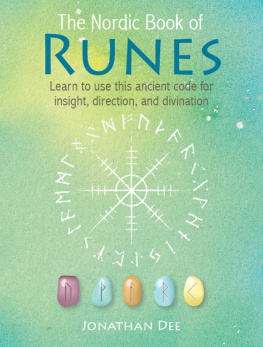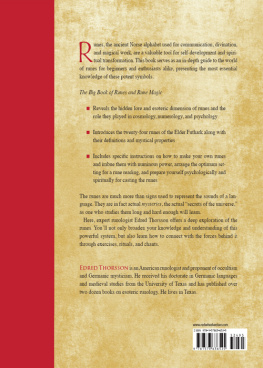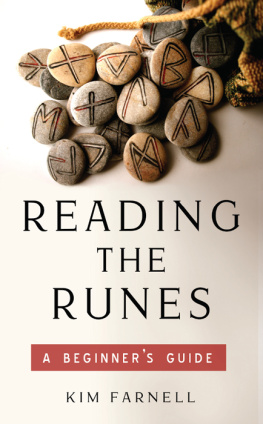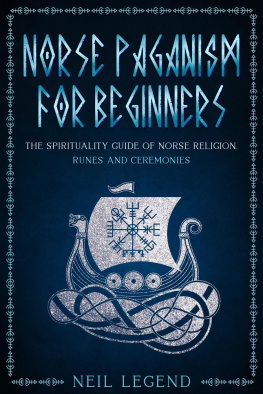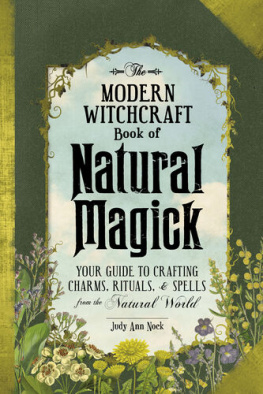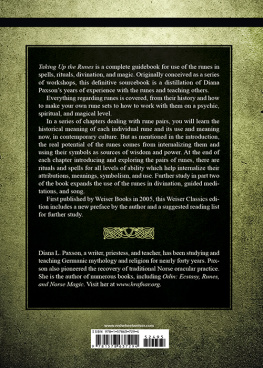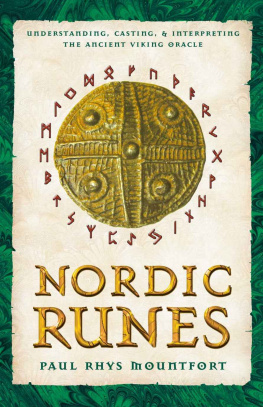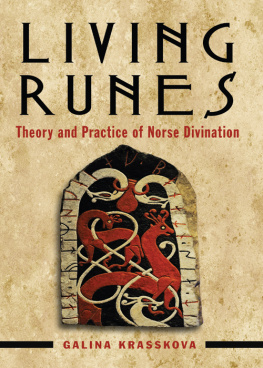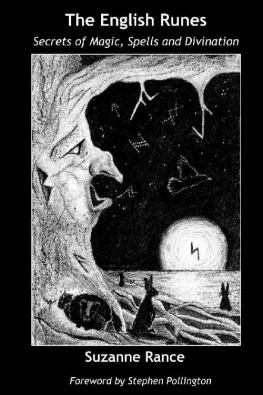Dee Jonathan - The Nordic Book of Runes
Here you can read online Dee Jonathan - The Nordic Book of Runes full text of the book (entire story) in english for free. Download pdf and epub, get meaning, cover and reviews about this ebook. year: 2020, publisher: Ryland Peters & Small, genre: Home and family. Description of the work, (preface) as well as reviews are available. Best literature library LitArk.com created for fans of good reading and offers a wide selection of genres:
Romance novel
Science fiction
Adventure
Detective
Science
History
Home and family
Prose
Art
Politics
Computer
Non-fiction
Religion
Business
Children
Humor
Choose a favorite category and find really read worthwhile books. Enjoy immersion in the world of imagination, feel the emotions of the characters or learn something new for yourself, make an fascinating discovery.
- Book:The Nordic Book of Runes
- Author:
- Publisher:Ryland Peters & Small
- Genre:
- Year:2020
- Rating:3 / 5
- Favourites:Add to favourites
- Your mark:
- 60
- 1
- 2
- 3
- 4
- 5
The Nordic Book of Runes: summary, description and annotation
We offer to read an annotation, description, summary or preface (depends on what the author of the book "The Nordic Book of Runes" wrote himself). If you haven't found the necessary information about the book — write in the comments, we will try to find it.
The Nordic Book of Runes — read online for free the complete book (whole text) full work
Below is the text of the book, divided by pages. System saving the place of the last page read, allows you to conveniently read the book "The Nordic Book of Runes" online for free, without having to search again every time where you left off. Put a bookmark, and you can go to the page where you finished reading at any time.
Font size:
Interval:
Bookmark:

The Nordic Book of
Runes


The Nordic Book of
Runes
Learn to use this ancient code for insight, direction, and divination

Jonathan Dee

This edition published in 2021 by CICO Books
an imprint of Ryland Peters & Small Ltd
2021 Jockeys Fields | 341 E 116th St |
London WC1R 4BW | New York, NY 10029 |
www.rylandpeters.com
10 9 8 7 6 5 4 3 2 1
First published in 2006 as Rune Wisdom
Text Jonathan Dee 2006 ( Kirsten Riddle 2015)
Design and illustration CICO Books 2006, 2021
The authors moral rights have been asserted. All rights reserved. No part of this publication may be reproduced, stored in a retrieval system, or transmitted in any form or by any means, electronic, mechanical, photocopying, or otherwise, without the prior permission of the publisher.
A CIP catalog record for this book is available from the Library of Congress and the British Library.
ISBN: 978-1-78249-744-8
E-ISBN: 978-1-80065-042-8
Printed in China
Editor: Liz Dean
Commissioning editor: Kristine Pidkameny
Senior editor: Carmel Edmonds
Senior designer: Emily Breen
Art director: Sally Powell
Head of production: Patricia Harrington
Publishing manager: Penny Craig
Publisher: Cindy Richards

CONTENTS

INTRODUCTION
WHAT ARE RUNES?
Runes are angular symbols, usually carved on stone, metal, or wood, that were made by the ancient Germanic peoples, the ancestors of the modern Germans, English, Frisians, and Scandinavians. These diverse races share a common heritage and once spoke closely related languages. It is not surprising, then, that they also shared an alphabetical tradition of making meaningful, enduring marks to commemorate important events, people, and beliefs.
The word rune, or runa, comes from the language of the ancient Goths (300600 CE) and literally means secret or hidden; this, in turn, ultimately derives from the early Germanic word ru, meaning, mystery. In modern German, raunen also comes from this root and means to whisper. Intricately carved runic stones can be found from the British Isles to Iceland, Germany, Norway, Denmark, Sweden, Finland, and Russia. There are even some claims that rune-stones have been found in North America. Many swords and pieces of jewelry found in the museums of the world are also inscribed with angular runes. These often display the name of the objects original owner and, alsoand this was most importantthe runic inscription showed that the object was of value, and that it was imbued with an aura of magical protection.
LEGENDARY MAGIC
From early times, rune-stones were considered to be magical. In around 100 CE, the Roman writer Tacitus described the lives and habits of northern European tribes. As part of his discourse, Tacitus mentioned that in times of trouble or confusion when the gods were to be consulted, the tribal chief would cast nine rune-carved staves onto a white cloth. He would then choose three at random and interpret the future from their symbols. This is the first reference to runes as a method of divination.
Yet, even during the first century CE, the runes were ancient; the earliest examples of runic symbols date from the Bronze Age. These were developed and refined around the second or third centuries BCE, when the northern tribes came into contact with the Mediterranean civilizations of Greece and Rome. However, the Germanic peoples did not believe that the runes were merely the work of man, and considered their origin to be none other than divinely inspired.

The ancient legends and sagas of the North recount the deeds of gods and heroes, but also within these imaginative tales are accounts of the magical origins of these potent symbols. The ninth-century Icelandic narrative poem The Havamal, meaning The Song of the High One, relates the spiritual journey of Odin, king of the Norse gods who, wounded by his own spear, hangs himself upon the world tree Yggdrasil for nine days and nine nights to gain the secrets of the runes:
Wounded I hung on a wind-swept gallows
For nine long nights, pierced by a spear,
Pledged to Odin, offered myself to myself.
The wisest know not from whence spring
The roots of that ancient tree.
They gave me no bread,
They gave me no mead,
I looked down;
With a loud cry I took up the runes;
From that tree I fell.

The knowledge that Odin gained through his suffering was much more than the ability to write. The runes were believed to contain a potent magical force, to hold within their symbols the secrets of creation and of time itself. To speak the name of a rune or to carve it upon an object was believed to summon an aspect of the power of the universe.
THE ELDER FUTHARK
The runic alphabet is known as a Futhark. This is because just as our word alphabet is derived from the names of the first two letters, alpha and beta, the Futhark expresses the initials of the first six symbols in the runic sequenceFehu, Uruz, Thurisaz, Ansuz, Raido, and Kaunaz: F, U, T, A, R, K.
Of course the eventual separation of peoples caused variations in runic sets to evolve over a period of time, resulting in sequences such as the Anglo-Saxon and Northumbrian runes. However, the oldest, most complete and established sequence of the runic alphabet is the Elder Futhark. It comprises twenty-four runes in the order shown opposite, and is usually divided into three groups of eight, or aetts: Freys aett (see ).

WYRD, THE BLANK RUNE
In modern times, a new rune has been added to the sequence, bringing the total to twenty-five. This new rune is represented as a blank stone. It has been given the name Wyrd, and in a reading it expresses the concept of fate.

RUNE SYMBOLISM
In the charts on , you will see each runes names and its variations, the letter of the alphabet it corresponds with, its symbolic meaning in divination, and its calendar association, or moons of the ancient Norse calendar. When you come to do a rune-reading, the calendar associations can help you to time eventstwelve of the runes relate to the Norse moons, so whenever these appear in a reading, they can help you to establishwhen a series of events occurred, or might happen in the future.
Font size:
Interval:
Bookmark:
Similar books «The Nordic Book of Runes»
Look at similar books to The Nordic Book of Runes. We have selected literature similar in name and meaning in the hope of providing readers with more options to find new, interesting, not yet read works.
Discussion, reviews of the book The Nordic Book of Runes and just readers' own opinions. Leave your comments, write what you think about the work, its meaning or the main characters. Specify what exactly you liked and what you didn't like, and why you think so.

